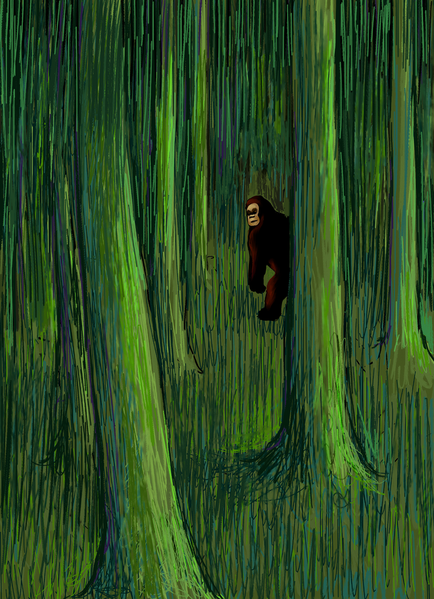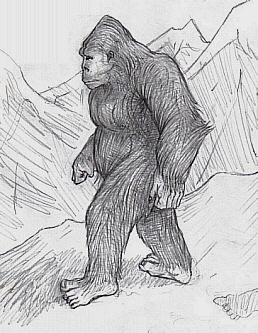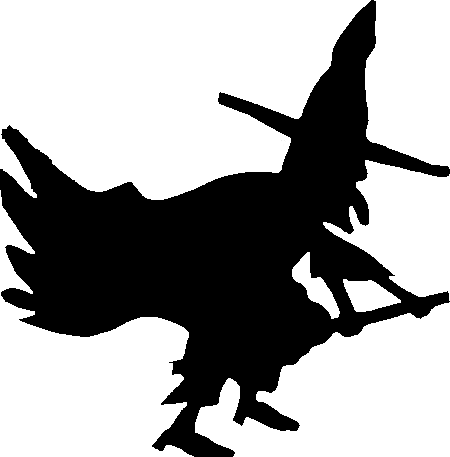3. Two mythical creatures
Focus on
Bigfoot
Katie says they met Bigfoot on her honeymoon in Canada.
It's time to find out more about this mythical creature:
Bigfoot, also known as Sasquatch, is the name given to an ape-like creature that some people believe inhabits forests, mainly in the Pacific Northwest region of North America. Bigfoot is usually described as a large, hairy, bipedal humanoid. Bigfoot. Sasquatch. Yeti. Ape-man. Man-beast. The shaggy, towering, yet elusive, creature goes by many names and there has been no shortage of tales of unexplained sightings in the woods.
People really want to believe Bigfoot is real, and for decades, dozens of Yeti hunters have tried to prove its existence. Never mind the fact that the only thing anyone knows for certain about the legendary beast is that it has been wildly successful at filling tabloids, being the subject of terrible B movies, and generally serving as an all-around punch line.
Most scientists discount the existence of Bigfoot and consider it to be a combination of folklore, misidentification, and hoax, rather than a living animal, because of the lack of physical evidence and the large numbers of creatures that would be necessary to maintain a breeding population. A few scientists, such as Jane Goodall, have expressed interest and some measure of belief in the creature. More recently Matt Moneymaker, Cliff Barackman, Ranae Holland and James "Bobo" Fay are a ragtag team of globetrotting researchers who are as serious about Bigfoot as the Pope is about religion. With every bit of cutting edge technology -night vision gear and all the sensors they can get their hands on- this group of Bigfoot hunters travels the world investigating Sasquatch sightings.
If you want to know more about their work click here.
Sources: http://abcnews.go.com/US/finding-bigfoot-ending-search-sasquatch/story?id=17718904#
http://en.wikipedia.org/wiki/Bigfoot
|
Licencia CC |
Many believers propose that the sasquatch is a giant primate, descended from the prehistoric gigantopithecus. Skeptics recognize that such a creature could exist, but hold that it is highly unlikely the creature could have lived close to inhabited areas for hundreds of years without anyone gathering conclusive evidence. The more likely explanation, according to the debunkers, is that several independent hoaxers have built up a collection of false evidence that has duped a very large number of people.
One of the most common types of sasquatch evidence is casts of giant footprints. Skeptics point out that this evidence is fairly simple to fake.
To make "bigfoot" prints, a prankster would just mold two large feet out of plaster, attach them to the bottom of his shoes and walk with a very long stride (possibly leaping with each step). The size and shape of supposed sasquatch footprints do vary considerably, which may indicate a number of unrelated pranksters. Sasquatch sounds could also be faked fairly easily, critics say, possibly using a computer program that alters sounds from an animal or human so the noise sounds completely alien.
As for photographic evidence (which is relatively rare), skeptics suggest that the documented sasquatches are actually people dressed in ape suits. Sasquatch-believers recognize that many photos and films are hoaxes, but they say that a few of them would be very hard to fake. The most famous piece of sasquatch evidence, the 1967 film shot by Roger Patterson in Bluff Creek, Cali., is at the heart of this debate. Several Hollywood insiders, including "An American Werewolf in London" director John Landis, have claimed that the film shows a man dressed in an ape suit. According to Landis, the suit was designed by John Chambers, the special-effects master who created the costumes for the original "Planet of the Apes" movies. Chambers denies any involvement, but the rumor persists.
Sasquatch believers say there are several details in the footage that indicate the creature is not a person. The main evidence is that the figure in the film keeps its knees bent while it is walking (see The Bigfoot Field Researchers Organization for pictures from the film). When humans walk, they lock their knees with each step, holding their legs straight. Believers also point out that the figure's skin and fur has a rippling motion, like a living creature's moving flesh, and that the surface of a costume would not move this way. Skeptics counter that the rippling-skin effect can be achieved by attaching a "water-bag" under the suit. According to E! Online: Bigfoot Movie: A Hollywood Hoax?, several Hollywood effects artists say the figure is obviously a guy in an ape suit with a water-bag fastened to his stomach.
But what about all the reported sightings? Believers make the point that people from all age groups, socioeconomic backgrounds and education levels say they've seen the creatures, indicating that the sightings are not an isolated phenomenon limited to a few pranksters and kooks. Skeptics counter that while these people aren't necessarily lying about what they've seen, they may be mistaken. A bear in the wild will stand up on its hind legs, possibly giving the impression of a tall primate. Impressions are highly subjective, skeptics note, and may be skewed when a person has heard a bunch of stories about a strange creature in the woods.
Many people want to believe in such an animal, for a number of reasons. It's a compelling idea that we could have completely overlooked such an enormous, remarkable creature all this time. Humans have always been obsessed with exploration: We yearn to uncover new things about the world. These days, many people have the feeling that there is nothing left to explore, that science and global expansion have uncovered most of the planet's secrets. The notion of the sasquatch (or other phenomena, such as the Loch Ness monster) is exciting because it restores some mystery to the world and gives ordinary people the chance to be adventurous explorers. In actuality, there is still a good deal of the planet that is unexplored (namely, the oceans). Scientists estimate that there are thousands of plants and animals left to discover under the sea, as well as in the tropical rainforests, but this is not common knowledge.
People are particularly interested in an undiscovered "ape-man" for the same reason they are fascinated by humanoid extraterrestrials. We are drawn to the idea of human-like creatures, with human-like intelligence, because it means that we are not alone in the universe. Some people believe these beings might be able to enlighten us about our own history. You can see this desire in the ancient folklore surrounding sasquatch and yeti. In these traditions, the creature has wisdom beyond our own and could provide us with spiritual guidance.
Whether the sasquatch is a real animal or only a product of hoaxes and imagination, its effect on human beings is the same. Simply put, it's a lot of fun to think that this creature exists. If somebody does finally prove the existence of sasquatches, the legend surrounding them will die out, replaced by scientific analysis. But if the creatures remain a mystery, there will always be believers -- it is nearly impossible to disprove something to everybody's satisfaction, and many people aren't interested in this sort of debunking evidence anyway. In the end, people will believe in sasquatches simply because it is exciting to do so.
This is the famous Patterson-Gimlin film:
And here you have a National Geographic video on the Bigfoot Hoax.
Culture counts
April Fools' Day is celebrated in many countries on April 1 every year. All Fools' Day is widely recognized and celebrated as a day when people play practical jokes and hoaxes on each other. The earliest recorded association between April 1 and foolishness can be found in Chaucer's Canterbury Tales (1392). In Spain an equivalent date is December 28, Christian day of celebration of the Massacre of the Innocents. After somebody plays a joke or a prank on somebody else, the joker usually cries out "Inocente!" (which in Spanish can mean "Innocent!", but also "Gullible!"). On the Spanish island of Minorca, "Dia d'enganyar" ("Fooling day") is celebrated on April 1 because Menorca was a British possession during part of the 18th century. In many countries newspapers and the other media participate—for example, with false headlines or news stories.
On 1 April 1957, the respected BBC news show Panorama announced that thanks to a very mild winter and the virtual elimination of the dreaded spaghetti weevil, Swiss farmers were enjoying a bumper spaghetti crop. It accompanied this announcement with footage of Swiss peasants pulling strands of spaghetti down from trees. Huge numbers of viewers were taken in. Many called the BBC wanting to know how they could grow their own spaghetti tree. To this the BBC diplomatically replied, "place a sprig of spaghetti in a tin of tomato sauce and hope for the best."
To this day the Panorama broadcast remains one of the most famous and popular April Fool's Day hoaxes of all time. It is also believed to be the first time the medium of television was used to stage an April Fool's Day hoax.
Here you can read more about this hoax and this is the BBC page that tells the story.
Moving on
Sasquatch is not the only mythical creature of Canadian origin. Have you ever heard of the Ogo Pogo?
The Ogo Pogo
Many large unidentified sea creatures have been sighted in lakes, rivers and oceans throughout the world. Certain fresh water bodies have also gained a reputation for containing sizable creatures often described as prehistoric dinosaurs, or dragons. The Loch Ness Monster is perhaps the most famous case of this in the world. However, Canada has it's own Lake Monster, The Ogopogo. The first sighting of the Ogopogo predates The Loch Ness Monster and is virtually the first such sighting of a creature of this type anywhere in the world.
Canada's famous water monster, The Ogopogo can be found in Lake Okanagan in the south central interior of British Columbia. Native Indian legends states that there has been a monster living in Okanagan Lake long before white men arrived in this country. Each year, sightings are reported of a creature some 20 to 50 feet long, with a horse shaped head and an undulating serpent-like body wih fins and feet. Cool! Okanagan Lake is about 80 miles long extending from Vernon at the north, to Penticton in the south with Kelowna in the middle. Sightings of The Ogopogo have been reported throughout the length of the lake but the creature appears to favour an section of the lake just south of Kelowna.
It's Really Jo' Mamma! The first recorded sighting of The Ogopogo by a caucasion was by Mrs. John Allison in 1872. Such sightings have continued to this day with many credible, rational and sober people claiming to have seen the beast. Native Indian folklore places the lair of the lake monster which they called N'ha-a-itk (lake demon), at a cave under Squally Point near Rattlesnake Island which is offshore from Peachland. The Native Indians would never paddle a canoe near this area without an offering for the creature because too often a storm would spring up and N'ha-a-itk would rise out of the waters to claim another life!
So save your money, instead of taking that trip to Scotland, take a trip to B.C. Check out the Ogopogo, and enjoy the interior of British Columbia. Who knows, maybe you'll be the one to finally get 'proof' of The Ogopogo!
Ogo Pogo is one of many mythological Lake Monsters, of which ythe most famous must be Nessie, The Loch Ness Monster. Watch this National Gepgraphic video about real unusual underwater creatures:
Here is a list of reported lake monsters.


